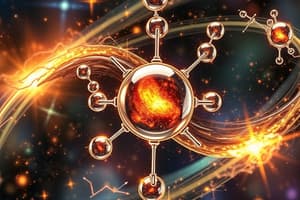Podcast
Questions and Answers
Which of the following is an example of a homogeneous mixture?
Which of the following is an example of a homogeneous mixture?
- Oil and vinegar
- Salad
- Saltwater (correct)
- Sand and water
A chemical change alters the composition of a substance, while a physical change only affects its state or appearance.
A chemical change alters the composition of a substance, while a physical change only affects its state or appearance.
True (A)
What is the chemical symbol for potassium?
What is the chemical symbol for potassium?
K
Density is defined as ______ per unit volume.
Density is defined as ______ per unit volume.
Match each element with its corresponding chemical symbol:
Match each element with its corresponding chemical symbol:
Flashcards
What is matter?
What is matter?
Anything with mass that takes up space, existing as solid, liquid, gas, or plasma.
What are elements?
What are elements?
Substances that cannot be broken down into simpler substances by chemical means.
What are compounds?
What are compounds?
Substances made of two or more elements chemically bonded together.
What is a homogeneous mixture?
What is a homogeneous mixture?
Signup and view all the flashcards
What is a qualitative physical property?
What is a qualitative physical property?
Signup and view all the flashcards
Study Notes
- Matter has mass and occupies space.
- Matter exists as a solid, liquid, gas, and plasma.
- Matter is composed of atoms and molecules.
Types of Matter
- Pure substances cannot be broken down, for example, Oxygen and Carbon.
- Compounds are composed of two or more chemically bonded elements, for example, Water.
- Mixtures can be homogeneous with a uniform composition such as saltwater.
- Mixtures can be heterogeneous with a non-uniform composition like a salad.
First 20 Elements & Symbols
- Hydrogen (H)
- Helium (He)
- Lithium (Li)
- Beryllium (Be)
- Boron (B)
- Carbon (C)
- Nitrogen (N)
- Oxygen (O)
- Fluorine (F)
- Neon (Ne)
- Sodium (Na)
- Magnesium (Mg)
- Aluminum (Al)
- Silicon (Si)
- Phosphorus (P)
- Sulfur (S)
- Chlorine (Cl)
- Argon (Ar)
- Potassium (K)
- Calcium (Ca)
Summary of Physical Properties
- Densities measure matter in a given volume.
- Density is measured as mass/volume.
- State of matter depends on temperature and pressure.
- Melting and boiling points are the specific temperatures at which a substance transitions.
Physical Properties
- Qualitative examples include: color, odor, texture, boiling point, melting point
- Quantitative examples include: mass, volume, density, and temperature
- Physical properties are measured with instruments or observed without measurement.
Physical Changes vs. Chemical Changes
- Physical changes alter state or appearance without changing the composition, for example, melting ice.
- Chemical changes produce new substances, for example, rusting iron.
Studying That Suits You
Use AI to generate personalized quizzes and flashcards to suit your learning preferences.




